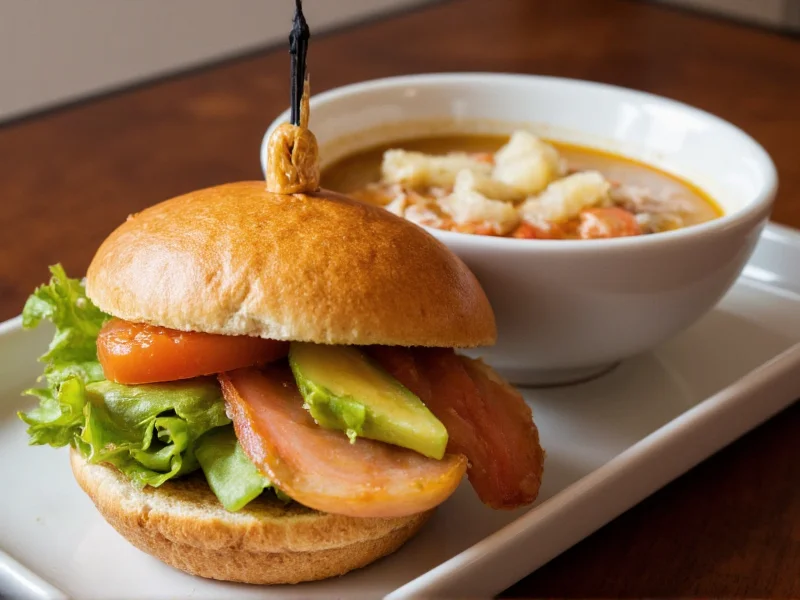For decades, the sandwich and soup combination has been a staple of casual dining, cafe menus, and home cooking. This enduring pairing isn't just tradition—it's backed by culinary science. When crafted thoughtfully, the right sandwich and soup create a balanced meal that satisfies multiple sensory dimensions simultaneously. Understanding the principles behind successful pairings transforms an ordinary lunch into a memorable dining experience.
The Science Behind Perfect Pairings
Successful sandwich and soup combinations follow specific culinary principles that create harmony between the two elements. Temperature contrast plays a crucial role—warm soup against room-temperature or slightly cooled sandwiches creates an appealing sensory experience. Texture balance matters equally; creamy soups pair beautifully with crunchy breads, while chunky soups complement smoother sandwich fillings.
Flavor chemistry explains why certain pairings become classics. The umami compounds in tomato soup enhance the savory notes in grilled cheese, creating what food scientists call "flavor layering." Similarly, the saltiness of a well-made BLT amplifies the sweetness in clam chowder. These interactions aren't accidental but follow established principles of taste perception.
Timeless Sandwich and Soup Combinations
Certain pairings have earned their classic status through generations of satisfied diners. These best sandwich and soup combinations work because they've been refined through culinary tradition and scientific principles:
| Sandwich | Soup | Why It Works |
|---|---|---|
| Grilled cheese | Tomato soup | Creamy texture balances crispy bread; shared umami creates flavor synergy |
| Ham and Swiss | Broccoli cheddar | Salty ham complements cheesy soup; similar richness creates harmony |
| Chicken salad | Cream of mushroom | Earthy mushrooms enhance poultry; creamy textures complement each other |
| BLT | Clam chowder | Saltiness of bacon enhances seafood sweetness; similar creamy textures |
| Tuna melt | Tomato bisque | Rich tuna balances acidic tomato; melted cheese bridges both elements |
Seasonal Pairing Guide
Adapting your sandwich and soup selections to the seasons creates meals that feel naturally appropriate. Seasonal soup and sandwich pairings connect us to the rhythm of the year and often feature fresher, more flavorful ingredients.
Winter Comfort Pairings: Hearty combinations like French dip sandwiches with beef barley soup provide warmth and sustenance during cold months. The rich broth penetrates the crusty bread, creating a satisfying textural experience that warms from within.
Spring Refreshments: Lighter options such as cucumber tea sandwiches with asparagus soup offer delicate flavors that match the season's renewal. The subtle herbal notes in both elements create a refreshing meal perfect for mild weather.
Summer Light Bites: Cold soup and sandwich pairings shine in summer heat. Try a caprese sandwich with chilled gazpacho for a Mediterranean-inspired meal that won't heat up your kitchen.
Autumn Harvest: Pumpkin soup with turkey-apple sandwiches captures fall's essence. The sweet-savory balance mirrors autumn's bounty, while warm temperatures provide comfort as temperatures drop.
Nutritional Balance in Sandwich and Soup Meals
Nutritious sandwich and soup lunch options can form a complete, balanced meal when properly constructed. The key lies in complementary nutrition—using the soup to provide elements the sandwich lacks, and vice versa.
A standard sandwich often delivers protein and carbohydrates but may lack sufficient vegetables. The soup component can address this imbalance by incorporating multiple vegetable servings. Conversely, a vegetable-heavy soup gains complete protein when paired with a protein-rich sandwich.
For healthy sandwich soup meal ideas, consider these principles:
- Pair whole-grain bread sandwiches with broth-based soups for balanced carbohydrates
- Combine lean protein sandwiches with creamy soups that use healthy fats
- Add leafy greens to sandwiches to complement vegetable-rich soups
- Use legume-based soups to boost fiber content when sandwiches feature refined grains
Mastering the Art of Pairing
How to pair sandwiches with soups successfully involves understanding several key factors beyond basic flavor matching. Temperature management proves crucial—soup should be hot but not scalding, while sandwiches should be at ideal eating temperature, not so hot that they burn the roof of your mouth.
Portion control separates a satisfying meal from an overwhelming one. The ideal ratio follows the "two-thirds soup, one-third sandwich" guideline, allowing both elements to shine without creating excessive fullness. For heartier sandwiches like grilled cheese, reduce the soup portion slightly; for lighter sandwiches like tea sandwiches, increase the soup portion.
Bread selection dramatically impacts the pairing experience. Crusty breads hold up better with chunky soups, while softer breads work with smooth, creamy soups. Consider toasting levels carefully—slightly under-toasted bread maintains structural integrity when dipped, while over-toasted bread becomes too brittle.
Creative Modern Interpretations
Contemporary chefs have expanded traditional sandwich and soup pairings with innovative combinations that honor the classic formula while introducing exciting new dimensions. These easy homemade soup and sandwich recipes demonstrate how culinary creativity can refresh familiar concepts.
Global fusion has produced remarkable pairings like banh mi sandwiches with Vietnamese pho broth, where the bright, herbaceous sandwich complements the aromatic broth. Korean bulgogi sliders with kimchi stew offer spicy-savory complexity that builds on traditional pairing principles while introducing new flavor profiles.
Gourmet upgrades transform classics: truffle-infused grilled cheese with roasted tomato soup elevates the standard pairing with earthy depth, while lobster roll with bisque delivers luxury without sacrificing the fundamental sandwich-soup harmony.
Practical Implementation Tips
Creating perfect sandwich and soup combinations at home requires attention to timing and technique. Prepare your soup first, allowing it to rest while you make the sandwich—this ensures both elements reach ideal serving temperatures simultaneously.
When constructing your sandwich, consider how it will interact with the soup. Open-faced sandwiches work better for dipping, while tightly constructed sandwiches hold their shape when served alongside soup. For optimal flavor integration, let your sandwich rest for two minutes after assembly before serving—this allows flavors to meld and prevents structural collapse.
Don't overlook the importance of accompaniments. A simple side salad can complete the meal, while artisanal pickles provide palate-cleansing contrast. Even the choice of beverage matters—a crisp white wine complements seafood pairings, while a light beer enhances heartier combinations.











 浙公网安备
33010002000092号
浙公网安备
33010002000092号 浙B2-20120091-4
浙B2-20120091-4